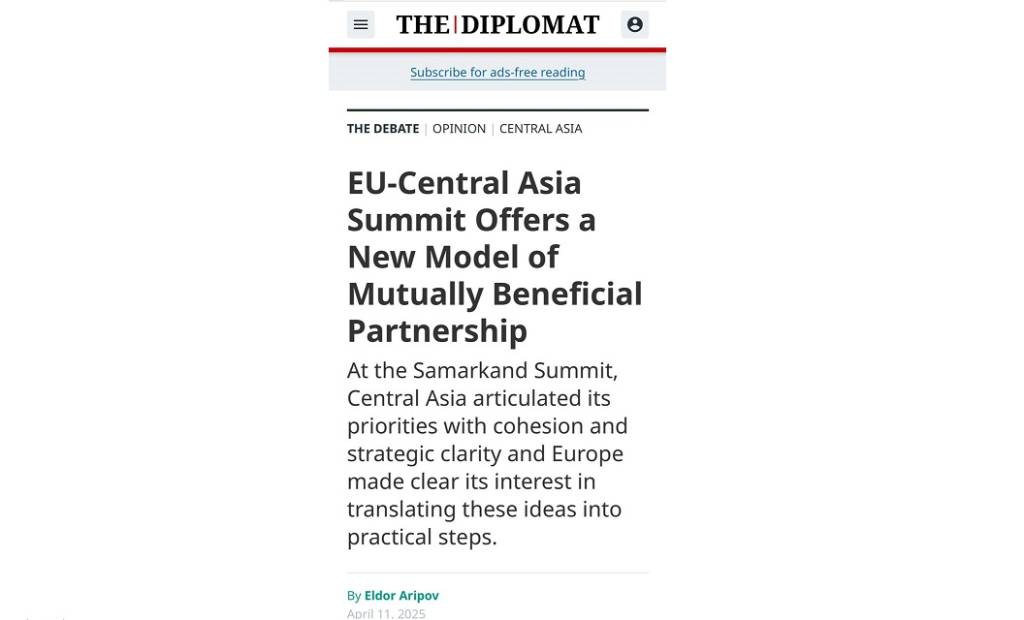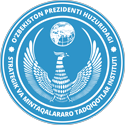The Diplomat about the Samarkand Summit

The Diplomat, an American publication, has published an analytical article by Eldor Aripov, Director of the Institute for Strategic and Regional Studies under the President of the Republic of Uzbekistan, titled “EU-Central Asia Summit Offers a New Model of Mutually Beneficial Partnership”.
The author writes that at the Samarkand Summit, Central Asia articulated its priorities with cohesion and strategic clarity and Europe made clear its interest in translating these ideas into practical steps.
The article emphasizes that, at a time when the international system is strained by crises of trust, conflict, and economic fragmentation, Uzbekistan, at the heart of Central Asia, demonstrated that an alternative agenda is not only desirable but increasingly achievable: one anchored in mutual respect, constructive cooperation, and joint efforts to address development challenges.
“Central Asia – a region bordering Russia to the north, China to the east, and Afghanistan to the south – was, just a decade ago, widely seen as a zone of unresolved conflicts and sealed borders. Today, it is gaining recognition as a region marked by increasing stability, connectivity, and openness”, Mr. Aripov writes. “A recent illustration of this transformation was the signing of the historic Agreement on the Junction Point of State Borders and the Declaration of Eternal Friendship by the leaders of Uzbekistan, Kyrgyzstan, and Tajikistan, just prior to the Central Asia-EU summit. These agreements helped resolve longstanding territorial disputes and opened new opportunities for regional cooperation”.

According to the European Bank for Reconstruction and Development (EBRD), Central Asia’s GDP is projected to grow by 6 percent this year – well above the global average. The region is gaining economic traction: intra-regional trade has increased 4.5 times, mutual investments have doubled, and the number of joint ventures has grown fivefold over the past few years.
ISRS Director notes that at the core of this progress is the foreign policy vision of President Shavkat Mirziyoyev of Uzbekistan, who early in his presidency declared a “zero problems with neighbors” approach. The region offers a potent combination of human capital and untapped natural resources. It is estimated to hold 7 percent of the world’s proven reserves of oil and gas, as well as a large share of rare earth elements essential to green technology and digital transformation. Over the past seven years, trade turnover between Central Asia and the EU has quadrupled, reaching 54 billion euros.
A key development was the signing of an agreement to open a regional office of the European Investment Bank in Tashkent. This move signals the EU’s commitment to deeper, long-term engagement in the region, with Uzbekistan emerging as a key partner.
Analyzing the summit’s outcomes, the expert writes that the EU increasingly sees Central Asia as a priority destination for investment in green energy, infrastructure, and innovation. The EU also expressed its intention to support the development of a carbon market in Central Asia and welcomed Uzbekistan’s proposal to establish a “Central Asia-EU Partnership for Clean Energy”. Europe is also investing in human capital. Plans include expanding access to Erasmus+ for Central Asian students, creating new academic exchanges in artificial intelligence, big data, and space technologies, and aligning the region more closely with the EU’s digital education and innovation agenda.
Based on an analysis of numerous facts, statistical data, and ongoing projects, the article emphasizes that the region has gained new political and economic growth momentum. Central Asian countries increasingly express their interests with a unified voice, and Samarkand has become the platform where this regional voice is represented and engaged.






